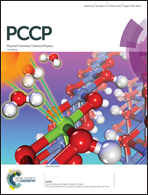Amphiphilic nanosheet self-assembly at the water/oil interface: computer simulations†
Abstract
In this paper, dissipative particle dynamics simulations are performed to study the interfacial and emulsion stabilizing properties of various systems of amphiphilic nanosheets (ANs) self-assembled at the oil/water (O/W) interface. The ANs have a dimensional symmetry structure that encompasses a triangular-plate at the center and two soft comb-like shells constructed with hydrophilic and hydrophobic polymers. As the simulation results show, the AN molecules are highly oriented in interfacial films with their triangular nanosheets parallel to the O/W interface, while their hydrophobic and hydrophilic segments attempt to immerse into the oil phase and aqueous phase, respectively. These results reveal that the rotation of ANs at oil/water interfaces is greatly restricted, meanwhile, their nanosheet (or planar) configuration facilitates their favorable orientation thereby, thus making the emulsion more stable. At higher concentrations, a wrapped-like or micelle morphology is observed. The O/W emulsions stabilized by ANs were also simulated, and it is interesting to find AN ‘patches’ at the O/W interface which resembles the leather patches on a football. By introducing the “amphiphilic nanosheet balance” concept, the hydrophilic–lipophilic balance (HLB) values of ANs were calculated. Due to their properties of two-dimensional symmetry, the HLB values of ANs tend to approximately 1 which reveals a stronger stability for emulsions.



 Please wait while we load your content...
Please wait while we load your content...